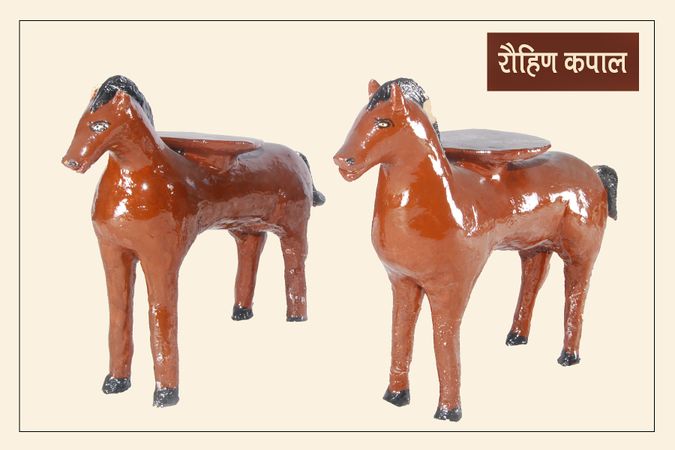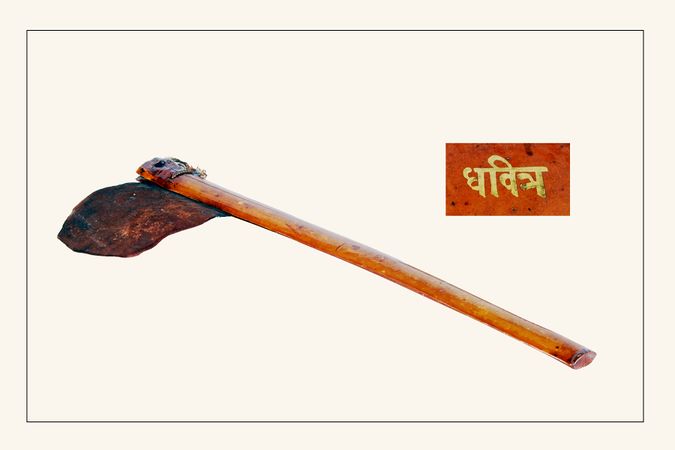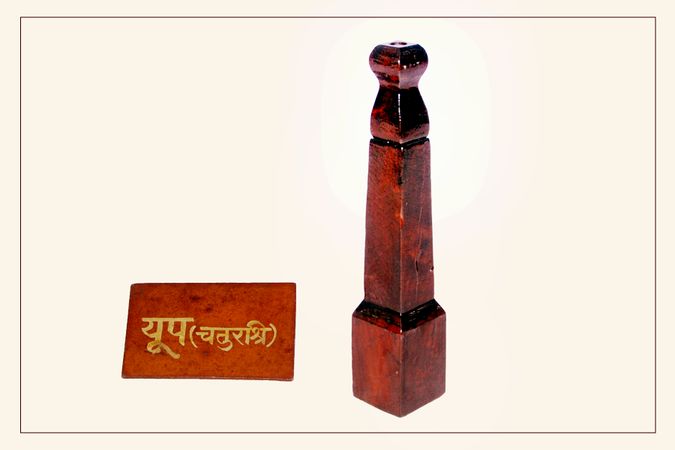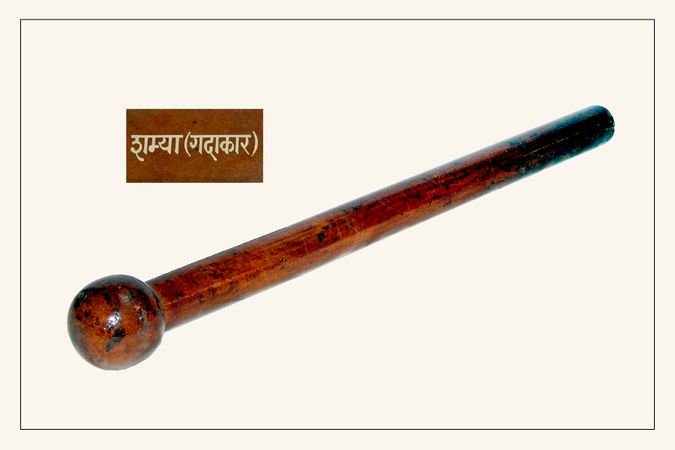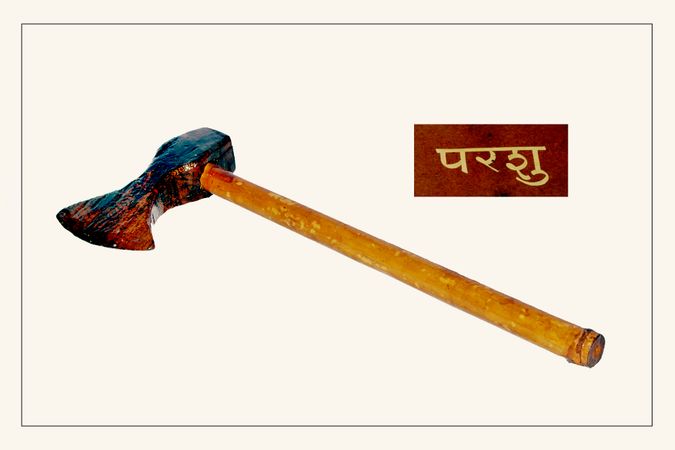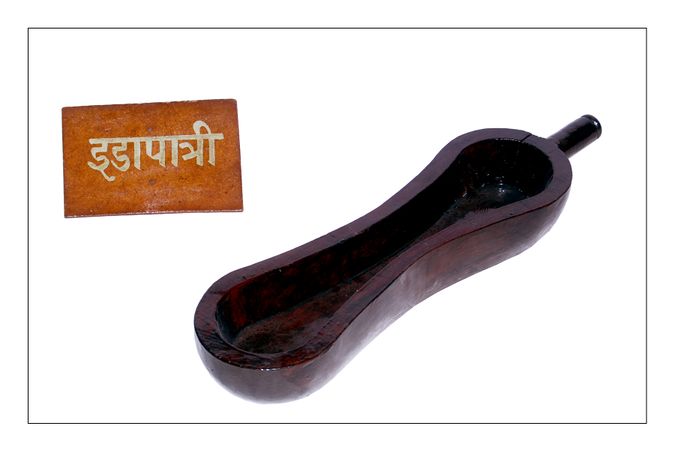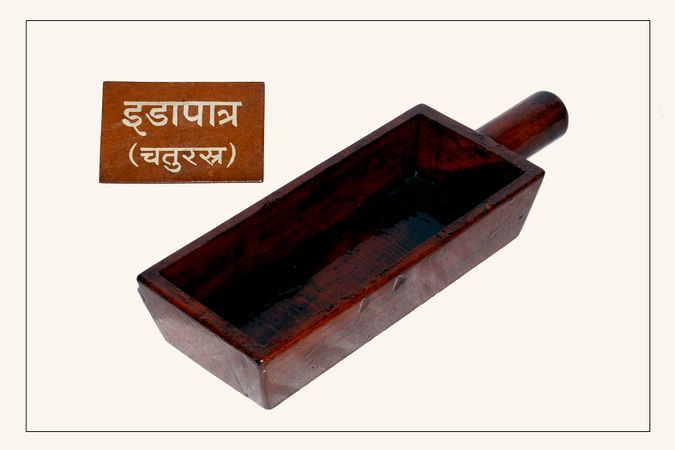Shrauta Yajnas (श्रौतयज्ञाः)
| This article needs editing.
Add and improvise the content from reliable sources. |
Shrauta karmas include the elaborate activities related to Shrauta yajnas and yagas meant for the well-being of mankind. These karmas are so called because their procedures are directly based on the Srutis or instructions given in Vedas. The brahmanas contain the description of yajnas (which last for many days) and different aakhyayikas as part of the Shrauta karmas (for example Haviyagnakandam of Kanvasatapatha brahmana contains the details of Haviryajnas). However, in Kalpas the rules are methodically compiled in mostly sutra format without the aakhyayika part.[1] Usually, Srauta karmas involve the Chaturhotr - the four priests (Hota, Adhvaryu, Udgaata, Brahma).
परिचयः ॥ Introduction
Texts of Kalpa Vedanga (कल्पः) mainly deal with elaborating the Vedic Yajna procedures and are classified under Shad Vedangas. The very name itself means ‘Kalpyate Samarthyate Yaga Prayogo Atra’ which means “the practice of Vedic ritual traditions are explained here”.
The first set of sutra literature in the Kalpa Vedanga namely, Shrautasutras provide guidance for the performance of Vaidika Yajnas. The performance of Vedic rituals is being continued even in the modern period especially in South India.[2]
The present article is based on the references of Shrauta sutras of Asvalayana, Apastamba, Katyayana, Baudhayana with occasional references to Samhitas and Brahmanas.
Classification of Shrauta Yajnas
- Yajna Upakarnas; Courtesy: Vaidik Samshodhan Mandal, Pune
Shrauta Yajnas are 14 in number. They are divided into two main groups of seven each : Haviryajnas and Somayajnas[1][3]. Shabdakalpadruma[4] describes the following list of Haviryajnas and Somayajnas.
तत्र श्रौताग्निकृत्य- हविर्यज्ञाः सप्त । यथा । आग्न्याधानं तदेवाग्निहोत्रम् १ दर्शपौर्णमासौ २ पिण्डपितृ-यज्ञः ३ आग्रयणम् ४ चातुर्म्मास्यः ५ निरूढ-पशुबन्धः ६ सौत्रामणिः ७ ।
श्रौताग्निसप्तसंस्थाः । यथा । सोमयागः स एवाग्निष्टोमः १ अत्यग्निष्टोमः २ उक्थ्यः ३ षोडशी ४ वाजपेयः ५ स द्बिविधः संस्था कुरुश्च । अतिरात्रः ६ अप्तूर्य्यामः ७ ।
| Haviryajnas | Somayajnas |
|---|---|
| अग्निहोत्रम् ॥ Agnihotra or (आग्न्याधानं ॥ Agnyadhana) | अग्निष्टोमः ॥ Agnistoma |
| दर्शपौर्णमासौ ॥ Darsapurnamasa | अत्यग्निष्टोमः ॥ Atyagnistoma |
| आग्रयणम् ॥ Agrayana | उक्थ्यः ॥ Ukthya |
| पिण्डपितृयज्ञः ॥ Pindapitryajna | षोडशी ॥ Sodashi |
| चातुर्मास्यः ॥ Chaturmasya | वाजपेयः ॥ Vajapeya |
| निरूढपशुबन्धः ॥ Nirudha Pashubandha | अतिरात्रः ॥ Atiratra |
| सौत्रामणिः ॥ Sautramani | आप्तोर्यामः ॥ Aptoryam |
Different Brahmanas and Sutras, however, mention different Haviryajnas though the Somayajnas remain the fairly same. Gopatha Brahmana (1.5.23)[5] describes the Haviryajnas and Somayajnas as follows
अग्न्याधेयम् अग्निहोत्रं पौर्णमास्यमावास्ये । नवेष्टिश् चातुर्मास्यानि पशुबन्धोऽत्र सप्तमः ॥ इत्य् एते हविर्यज्ञाः
अग्निष्टोमोऽत्यग्निष्टोम उक्थ्यः षोडशिमांस् ततः । वाजपेयोऽतिरात्रश्चाप्तोर्यामात्र सप्तमः ॥ इत्य् एते सुत्याः
Agnyadheyam and Navesti are given Gopatha Brahmana as part of the Haviryajnas, where Agrayana and Pindapitryajna are not mentioned. Aitreya Aranyakam (2.3.3) (belonging to Rig veda) describes five categories of shrauta yagnas as follows
स एष यज्ञः पञ्चविधोऽग्निहोत्रं दर्शपूर्णमासौ चातुर्मास्यानि पशुः सोमः (Aitr. Aran. 2.3.3)[6]
- Agnihotra
- Darsapurnamaasa
- Chaaturmasya
- Pasu
- Soma
Gautama Dharmasutras also enumerate the seven haviyajnas and seven somasamsthas. Agnyadhana is also a haviryajna according to Gautama Dharmasutras (1.8.20)[7]
अग्न्याधेयमग्निहोत्रं दर्शपूर्णमासावाग्रयणं चातुर्मास्यानि निरूढपशुबन्धः सौत्रामणीति सप्तहविर्यज्ञसम्स्थाः ॥
Here we see instead of Pindapitryajna, Agnyadheya (also called Agnyadhana) is described as one of the seven Haviryajnas.
The most common of these yajnas is the Agnihotra, where daily havis of milk is given in the three fires, every morning and evening. Apart from Agnihotra, Darsapurnamasa (performed on New and Full Moon days) and Chaturmasya (performed at the beginning of three seasons) are also important and conducted by few people even in the present days.
General Rules in Shrauta Yajnas
Some of the general rules applicable in all shrauta karmas, from the Asvalayana Srautasutras (1.1.8 to 22) summarized in pages 982 - 983 of reference[7] are given below.
तस्य नित्याः प्राञ्चश्चेष्टाः ८ अङ्कधारणा च ९ यज्ञोपवीतशौचे च १० विहारादव्यावृत्तिश्च तत्र चेत् कर्म ११ एकाङ्गवचने दक्षिणं प्रतीयात् १२ अनादेशे १३ कर्मचोदनायां होतारं १४ ददातीति यजमानं १५ जुहोति-जपतीति प्रायश्चित्ते ब्रह्माणं १६ ऋचं पादग्रहणे १७ सूक्तं सूक्तादौ हीने पादे १८ अधिके तृचं सर्व्वत्र १९ जपानुमन्त्रणाप्यायनोपस्थानान्युपांशु २० मन्त्राश्च कर्म्मकरणाः २१ प्रसङ्गादपवादो बलीयान् २२ (Asva. Shra. 1.1.8 to 22)[8]
- Unless expressly stated, the yajamana should always face the north direction and sit cross-legged.
- The yajnika materials (kusa etc) should have their ends pointed towards the east direction.
- The sacred thread (yajnopavitam) should be worn in all activities, in the upavita form, except where the nivita or prachinaviti form is expressly ordained.
- Whenever a limb (anga) is mentioned, or no particular limb is mentioned, the right limb (hand, foot, finger) is meant.
- Whenever the word "dadati" is used the yajamana is the agent of the action.
- When any rite is prescribed without expressly stating the performer, it is the Hotr who does it, and in the case of prayaschittas wherever the words juhoti and japati occur the Brahman priest is the agent to perform those acts.
- When the first pada of a Rk mantra is mentioned for being employed in any rite the whole mantra is intented to be recited.
- When the first words of a Sukta (not amounting to a pada of mantra) are mentioned for being employed in any rite then the Sukta is to be recited; if the first words of a Sukta amounting to more than a pada of mantra are mentioned, it is intended that three verses are to be recited (that verse and the following two).
- Japa, amantrana, abhimantrana, apyayana, upasthana, and mantras that indicate the rite that is being performed are to be recited in a low voice (Upamsu).
- A special rule (apavada) is stronger than a general rule (प्रसङ्गः prasanga).
Brief Description of Haviryajnas
Agnihotra, is a term specifically applicable to the first and important vaidika yajnas classified among the seven Srauta karmas - हविर्यज्ञानि ॥ Haviryajnas (offering of havis is made) or homas. It is performed as a daily worship to Agni and also with an intent to fulfill any specific desire[9][10].
References
- ↑ 1.0 1.1 Purkayastha, Dipanjona (2014) Ph. D Thesis from Assam University : A Study of the Asvalayana srauta sutra with reference to the principal sacrifices
- ↑ Radhakrishna Bhat, N. Vedic Ritual Tradition of Karnataka, Vedic Heritage Portal.
- ↑ Introduction to Rituals (Vedic Heritage Portal)
- ↑ Shabdakalpadruma (See Haviryajnas under Yaga)
- ↑ Gopatha Brahmana (Purvabhara Prapathaka 5)
- ↑ Aitreya Aranyakam (Aranyakam 2)
- ↑ 7.0 7.1 Kane, Pandurang Vaman. (1941) History of Dharmasastra (Ancient and Medieval Religious and Civil Law) Volume 2, Part 2. Poona : Bhandarkar Oriental Research Institute
- ↑ Asvalayana Shrautasutras (Adhyaya 1)
- ↑ http://www.hindupedia.com/en/Agnihotra#cite_note-1
- ↑ Venkateswara Rao. Potturi (2010) Paaramaathika Padakosam Hyderabad: Msko Books


